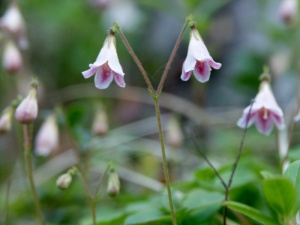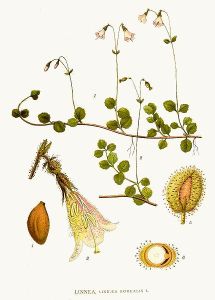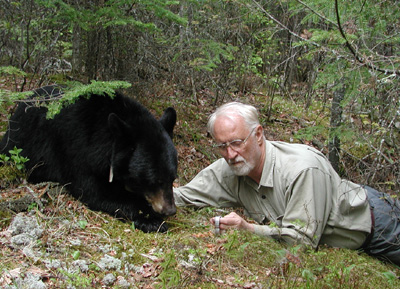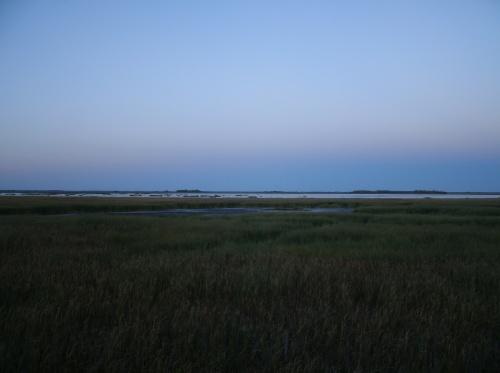Well not exactly. I’m still in Minnesota, but my blog has moved to the Southern Fried Science Network, also known as The Gam. My new address is http://zoologirl.southernfriedscience.com! Sorry to make you update bookmarks and whatnot, but I’m really excited about joining a network of fellow science bloggers! I’ll still be blogging about the same topics, so please join me at my new home. And while you’re at it, check out the collection of great science bloggers also on the Southern Fried Science Network.
No quick links this week. I’ve been pretty busy and haven’t had much time to even read! I soon will have time for more blogging though and also a big announcement!
But, a few weeks ago, I asked if anyone could name Carl Linnaeus’s favorite plant. I figured I should follow-up on that (even though no one tried to answer).
*drumroll*
The answer is Twinflower (Linnaea borealis)! From the photo above, you can probably tell how the plant received its common name. As for the scientific name, you may think that Linnaeus named the plant after himself, being the father of modern taxonomy and all. However, it was his teacher and friend Jan Frederik Gronovius that named the plant in his honor. On the naming, Linnaeus wrote:
“Linnaea was named by the celebrated Gronovius and is a plant of Lapland, lowly, insignificant and disregarded, flowering but for a brief space – from Linnaeus who resembles it.”
Twinflower grows around the world at northern latitudes. I’ve come across it often here in Minnesota. It really is an adorable plant, especially when flowering, and I can see why it was Linnaeus’s favorite.
Posted in Frivolous Fact, Plants | Tagged botany, linnaeus, Minnesota, plants, science |
On a Thursday!
- First, something that put a smile on my face. One of my posts was included in the most recent edition of Scientia Pro Publica (Science for the People) blog carnival! There are plenty of great blog posts about science in this edition about everything from drunk bats and venomous mammals to discussions of the peer-review process. So go check it out!
- Cosmic curiosity reveals ghostly glow of dead quasar– discovered through the citizen science project Galaxy Zoo!
- Do you ever get sad from reading about endangered species and losses of biodiversity? Then you must read Back from the Brink: Victories in Conservation over at Southern Fried Science. It discusses a recent paper in Science which shows conservation efforts are helping to slow extinctions. I couldn’t help but notice that a few of the success stories they highlighted are in part thanks to zoo breeding programs, including that of the the Asian Wild Horse. The Minnesota Zoo played a significant part in their recovery, and here’s a great video on that story.
- And related to my rant yesterday, I think the paper mentioned above supports how important scientific publications can be, especially considering the paper provides evidence that conservation efforts work and need more support. In addition, one of the co-authors is none other than the Minnesota Department of Natural Resources’ Bear Biologist David Garshelis. He is also co-chair of the IUCN Bear Specialist Group, and was recently on The Colbert Report sticking to his story that he’s not afraid of bears. Videos below!
Posted in Conservation, Minnesota, Quick Links, Wildlife | Tagged Asian Wild Horse, Bears, biodiversity, Citizen Science, conservation, Endangered Species, Minnesota, Minnesota Zoo, Research, science, The Colbert Report, wildlife, zoos |
For a while now, I have considered writing about the controversy surrounding Dr. Lynn Roger’s black bear research and whether collared bears should be protected from hunting. I haven’t done so yet because I haven’t formed a solid opinion, can see both sides of the argument, and am not a bear hunter. But recently, Lynn Rogers made some comments that I can’t ignore.
Posted in Conservation, Minnesota, Wildlife | Tagged american black bear, bear hunting, Bears, black bears, Ely, ely mn, hunting, lily and hope, lily the black bear, lynn rogers, Minnesota, Research, science, wildlife, wildlife research, Wildlife Research Institute | 8 Comments »
I’ve had zero time to blog lately. Hopefully, I will have some time by the end of this week. But, I did still get the chance to put together a quick links for this week!
- It’s almost Halloween! If you will be giving out candy this Halloween, make sure it doesn’t contain non-sustainable palm oil that harms Orangutans and other wildlife by following the Orangutan Friendly Halloween Candy Guide (.pdf file). You can learn more about Orangutans and the Palm Oil Crisis here.
- More reasons why I wish I had a smart phone: What kind of beetle? This app knows.
- New tools use citizen science to monitor wildlife diseases and human health.
- From the Star Tribune: The Bear Whisperer. An in-depth look into Lynn Roger’s and The Wildlife Research Institutes’s Black Bear Research. However, I don’t think the article fully delivers on the “But not everyone agrees with methods of Lynn Rogers” aspect of the story and the controversies surrounding this research and bear hunting. I may write more on this if I get enough time in the near future.
- In my last Quick Links, I asked if anyone could name the favorite plant of Carl Linnaeus without looking it up. No one answered! I’ll give you all one more chance to answer (you can even look it up this time- but then you have to add some extra info you find interesting :)). Either way, I’ll write up a post this weekend with the answer.
Posted in Quick Links | Tagged apps, Bears, candy, Citizen Science, conservation, halloween, lily the black bear, lynn rogers, orangutans, palm oil, plants, Research, science, smart phones, wildlife, wildlife diseases |
This grass was much taller than me! I don’t know what kind of grass it is, so if anyone just happens to be able to identify it from the photo, I would love to know! 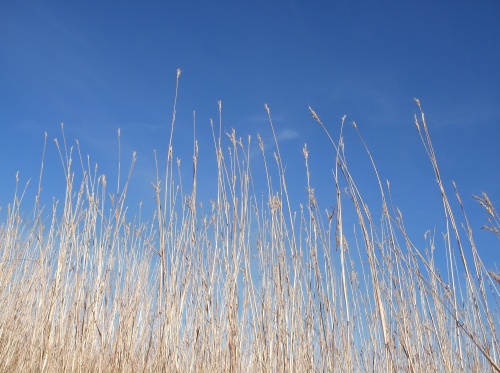
See more skies from around the world at SkyWatch Friday!
Posted in Skywatch | Tagged grass, photography, skywatch friday, This | 9 Comments »
- Linnaeus, Shlinnaeus! – Fun scientific names! Though the author didn’t mention one of my favorites Aptostichus stephencolberti named after none other than Stephen Colbert. I’ll give props to anyone who can name Linnaeus’s favorite flower (without looking it up). Anyone?
- It’s Wolf Awareness Week! So, I’m going to focus the rest of this post on wolves. The International Wolf Center has information galore online about wolves. You can learn from Frequently Asked Questions, keep up with wolves in the news, read full text scientific articles, find fun activities for kids, track wild wolves, and much, much more! The center is located in Ely, Minnesota and definitely worth a visit if you live anywhere nearby.
- Recent news: Idaho’s governor says state will no longer manage wolves or control poaching
- And I’ll finish off this Quick Links with some awesome wolf videos:
Wolf communication and hunting (David Attenborough does a pretty decent howl!) Source
From BBC Planet Earth: Wolves hunting caribou Source
Wolves Fishing! Source
Posted in Conservation, Events, Wildlife | Tagged events, international wolf center, links, linnaeus, Minnesota, science, stephen colbert, wildlife, wolf awareness week, wolves | 3 Comments »
Two things I love the most about citizen science are:
- science starts with an observation.
- Humans spend a good percentage of time “observing.”
That means average citizens might be observing phenomenon that scientists are looking for every day. Tapping into non-scientists’ observations has great potential to advance science and lead to interesting questions.
Case in point: When Freddy Johansen, a tourist on a whale watching boat, took a photo of a humpback whale off the coast of Madagascar in 2001, he had no idea it would break a record for these long distant travelers. Because back in 1999, researchers had photographed the same whale. However, that photo was taken off the coast of Brazil. That’s a 9,800 kilometer journey at least and more than twice the distance of the typical seasonal migration! The previous record sat near 9,400 kilometers.
Additionally, this whale was a female. This is surprising because female whales travel much shorter distances than males, and the only other humpback known to travel from the South Atlantic Ocean to the Indian Ocean was male.
This new record has researchers questioning how much we really know about whales. Some scientists are wondering if this indicates that migration patterns are changing in response to the previously endangered species’ recovery. From Nature News- Humpback Whale Breaks Migration Record:
Daniel Palacios, an oceanographer at the University of Hawaii at Manoa, says … Behaviours often change as population densities grow; for instance, animals may disperse to avoid competition for food…
The female could have been following prey, exploring new breeding habitats, responding to distant calls, or simply wandering astray. “We generally think of humpback whales as very well studied, but then they surprise us with things like this,” Palacios says. “Undoubtedly there are a lot of things we still don’t know about whale migration.”
Now you might be wondering why everyone is talking about this now when the photos were taken in 1999 and 2001. Are scientists really that inefficient? Not quite.
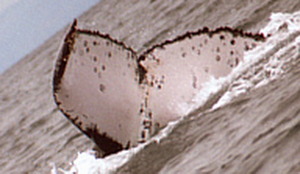
Spot patterns on whales' tails can be used like human fingerprints to identify individuals. Photo taken by Freddy Johansen
Back in 2001, Freddy Johansen didn’t know about the Atlantic Humpback Whale Catalog that researchers use to compare photographs of spot patterns on whales’ tails and determine if they are of the same whale at different locations. However, he did recently upload his photo to Flickr where one whale researcher (Gale McCullough of Allied Whale: see her comment below!) often checks for such photos. Connecting these two photos lead to this record-breaking discovery and Freddy Johansen becoming a coauthor on a scientific paper.
Pretty cool if you ask me, and if you have any clear photos of whales’ tails like the one above, you can also submit them to the Atlantic Humpback Whale Catalog. I wonder what other types of photos could be floating around the internet or in someone’s scrapbook with the potential to change what we know and make a scientist out of an unsuspecting citizen.
Quick Update 2:
Not only did the internet allow Gale McCullough to find Freddy Johansen’s photo, it allowed Freddy and Gale to find what I wrote! They both commented below, so be sure to check out the link to Freddy’s photo on Flickr with his retelling. Also, take a look at the comments on his photo and get a glimpse of how the story unfolded!
Gale also provides a great background story and explains how all the pieces fell into place for this discovery (read the first comment on the photo).
Posted in Citizen Science | Tagged Citizen Science, conservation, humpback whales, marine biology, photography, Research, science, whales | 5 Comments »
I’m posting this photo for Skywatch Friday from my duck banding adventure at Agassiz National Wildlife Refuge to highlight National Wildlife Refuge Week (10/10-10/16).
Though you can’t see them in the photo, there’s a few ducks and Sandhill Cranes out there that I had spotted with my binoculars!
And one more photo from Rydell National Wildlife Refuge. We Minnesotans love our many statues:
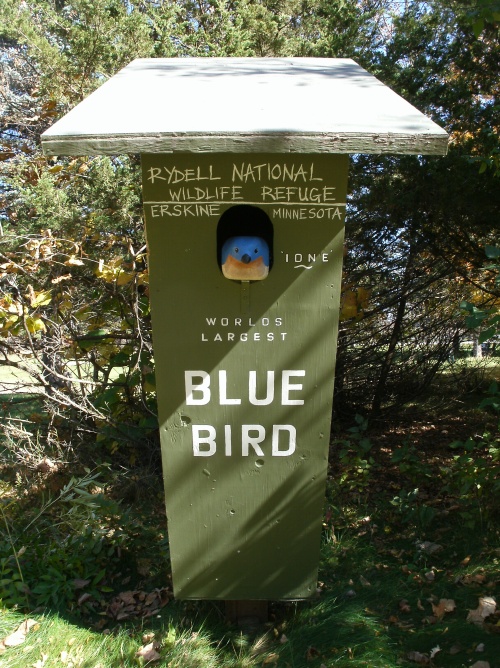 Check with your local refuge to see if there are any events going on near you!
Check with your local refuge to see if there are any events going on near you!
Check out more skies from around the word at Skywatch Friday!
Posted in Skywatch | Tagged National wildlife refuge, photography, skywatch friday | 6 Comments »
I recently discovered twitter. I had of course heard of it before and occasionally stumbled over there. But now that I’ve actually signed up and am using it, I am overwhelmed by the flow of information. There is so much to read!
Anyway, here are some links I’ve stumbled across recently. I know I wanted to add more, but I’ve read so much that I’ve lost track of them…
- New Citizen Science Project! Old Weather is a croudsource project from Zooniverse asking people to help scientists build better climate models by going through ship logs from the early 1900s. Should be fun for both history and science enthusiasts!
- In zoos, animal shelters, and in the wild, humans tend to favor helping more attractive or cute animals. Check out It’s Raining (Black) Cats and Dogs and The advantage of attractiveness… in the zoo.
- Do you think that birds sleep in nests, beavers pack mud with their tails or penguins fall over when a plane flies overhead? Then be sure to read Top Ten Nature Myths Debunked.
- Check out these photos from around the word taken during 350.org‘s global work party for climate action on 10/10/10.
Posted in Quick Links | Tagged Citizen Science, climate, conservation, myths, nature, weather, zoos | 4 Comments »
